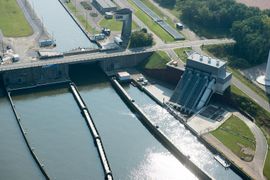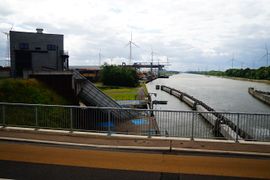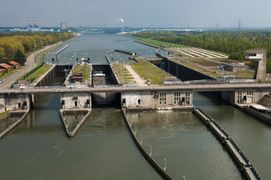Ham test case
| Fact box: Ham | |
|---|---|
| Country | Belgium |
| River | Albert canal |
| Operator | De Vlaamse Waterweg |
| Capacity | 1.2 MW |
| Head | 10 m |
| Inter-annual discharge | |
| Turbine(s) | 1 Archimedes screw turbine |
| Detailed report | Click for pdf |
File:BrokenThis article needs some revision. The parts about the Archimedes screws are not clear.
Contents
Introduction
The shipping lock complex and accompanying HPP studied here is located in the Albert canal in the municipality of Ham (Kwaadmechelen, Belgium). The Albert canal is one of the most important shipping routes of Flanders as it connects the River Scheldt via the Port of Antwerp, with the River Meuse and the Juliana Canal. It was dug in the 1930’s.
The ship lock complex of Ham is situated at 77,2 km of the river Meuse. The canal and its side-canals are almost entirely fed by water of the river Meuse, and are directly connected to it in the city of Liège. The water in the Albert canal is used for shipping, industry, drinking water supply, irrigation, and cooling of the nuclear power plant of Antwerp. The discharge of the Canal is regulated and depends on the discharge of the river Meuse.
The river Meuse is a typical rain fed river that stretches from France through Belgium ending up in an embanked estuary in The Netherlands with a total fall of 409m. This 935km long river has a discharge area of 36.000km² and its mean discharge is 230m³, peaking up to tenfold after long and heavy rainfall. The hydrology of the Albert canal is entirely artificial and controlled by humans for shipping and other purposes. The water level in each canal section depends on the water supply from the Meuse river, besides rainfall and the shipping/ship lock activity, the withdrawal of water for irrigation, drinking or cooling water, and the use of water for electricity production by the Archimedes screws in the pumping/hydropower station(s).
About the hydropower plant
The ship lock complex of Ham, as well as the ones of Olen and Hasselt, is by-passed by a small channel that runs through the hydropower station. The hydropower station contains the largest Archimedes screw in the world, which cannot only pump, but also turbinate water (two operational modes for one and the same screw).
The hydropower station in Ham has one closed Archimedes screw. This screw has its housing attached to the blades, preventing fish from being squeezed between the blades and the housing. This screw, which is supposed to be fish-friendly, can only pump water and cannot serve as a turbine. It has a length of 22 m, a diameter of 4.3 m, an inclination angle of 38° and a weight of 85 tons. The highly efficient Archimedean screw is able to generate electricity 24 hours a day, whilst maintaining the natural flow of a river. It has an installed capacity of 1.2 MW
Layout
The area around the HPP is highly artificial. The hydropower station, which also serves as pumping station, is located in a by-pass channel ( 380 x 6 meters) bridging the ship lock complex of Ham. This by-pass channel is a concrete channel. Fish can freely swim from the Albert canal to the by-pass channel. The Albert canal itself is a large concrete shipping canal. It is 130 km long and runs nearly straight from the river Meuse in the East of Belgium to the river Scheldt in the West. The height difference between the rivers Meuse and Scheldt is bridged by 6 shipping lock complexes. Each ship lock complex has two ship locks of 136 by 16 m and one push-convoy lock of 200 by 24 m. The banks of the canal over its 130 km length are concrete and straight and thus not even semi-natural.
The Operator: De Vlaamse Waterweg
The “Vlaamse Waterweg NV” is an agency of the Flemish government. It manages and operates the waterways as a powerful network that contributes to the economy, prosperity and liveability of Flanders. The “Vlaamse Waterweg NV” strengthens transport via inland shipping, ensures water management and increases the attractiveness of the waterways for recreation, tourism and nature experience. Read more.
Pressures on the water body's ecosystem
Polution: The water quality of the Albert canal is rather good, although lots of industry is situated in the area of the canal. The surface water is also used for drinking water supply. Nevertheless, the biological live is moderate due to the highly artificial morphology of the river. This is reflected in the Index of Biotic Integrity (IBI), which indicates that the state of the fish populations in the Albert canal is only moderate to poor.
Morphology: The HPP is situated in a by-pass channel of a large shipping canal. Hence, both the morphology as well as the hydrology in this area is highly artificial. The banks are vertical and made of concrete and water vegetation is absent. The water level and flow are regulated by the shipping lock complexes and accompanying pumping/hydropower stations. The net flow is directed from the Meuse River to the Scheldt river. However, the instant flow can be directed either towards the Scheldt river or the Meuse river, depending on the emptying and filling of the shipping lock complexes upstream and downstream of each of eight canal section.
Migration delay: Notwithstanding the highly artificial nature of this aquatic system, diadromous fish species use the shipping canal as a migration route to and from the North Sea. While fishmigration is happening, it is heavliy delayed du to the presence of several ship lock complexes on the canal.
Test case topics
Fish population
As indicated by the Index of Biotic Integrity (IBI), the fish community in the Albert canal has a poor to moderate state. Catch efforts in the canal for the European Water Framework Directive between 2014 and 2018, indicate the occurrence of 20 fish species of which roach (Rutilus rutilus) is the far most dominant species. Unfortunately the fish community in the canal suffers a lot from exotic species, such as the round goby, which is the third most dominant fish species already. The fish populations even suffer from the dominant occurrence of the exotic, red swamp crayfish (Proterorhinus semilunaris).
Fish migration
There is no migration device. The potential routes for a fish to migrate are:
- Migrate upstream trough a ship lock by swimming though the downstream and upstream open gates
- Migrate upstream by passing the Archimedes screws of the hydropower plant in pumping mode
- Migrate downstream through a ship lock by swimming passed an open gate
- Migrate downstream through a ship lock by passing through the filling system
- Migrate downstream from the ship lock to the canal through either an open gate, or the emptying system of the ship lock
- Migrating downstream through the by-pass channel leading to the hydropower plant and passing through the Archimedes screws in turbine mode.
Research objectives and tasks
At the shipping canal and ship lock complex of the Test Case Ham, the impact of Archimedes screw hydropower plant on the local fish population is investigated. Specifically: The impact of the hydropower station (3 open Archimedes screws as turbines) on fish that pass the screws is studied by evaluating the mortality and injury of fish that passed the screws in turbine mode. The impact of the hydropower station on fish is evaluated through several pressure-related parameters by barotrauma sensor tests that pass the screws. The impact of the hydropower plant on the local fish population and downstream migrating eel and salmon is investigated by evaluation of the (relative) number of fish that pass the sluice complex in the downstream direction by the by-pass channel and hydropower station (instead of taking the ‘route’ of the ship locks in the canal).
Research tasks
The research tasks and field studies conducted at Ham are:
- Life fish experiments for turbine induced damage
- Testing of barotrauma stress caused by turbine passage with sensors (Barotrauma Detection System)
- Acoustic telemetry study on downstream migration pathways of european eel and salmon smolts


